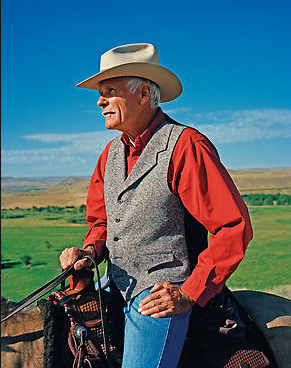Cowboys & Indians
Ted Turner — media mogul, bison breeder, restaurateur, and philanthropist — is America’s largest individual landowner, with 2 million acres across 12 states and Argentina.
Ted Turner came to be the biggest individual landholder in the West by way of the South.
Born in Ohio and raised in Georgia, Turner early on developed an affection for the movie Gone with the Wind, taking to heart in particular Gerald O’Hara’s words to his daughter Scarlett: “Why, land is the only thing in the world worth workin’ for, worth fightin’ for, worth dyin’ for. Because it’s the only thing that lasts.”
Even now, at age 70, Turner periodically peppers his conversations with dialogue from his favorite movie. During his heyday at the helm of Turner Broadcasting Systems Inc., he once joked that he purchased the film studio MGM/UA Entertainment Co. in 1986 for $1.5 billion primarily so he could personally own Gone with the Wind.
In actuality, the epic was just one of hundreds of titles in the MGM/UA library Turner used to program Turner Network Television (TNT) and Turner Classic Movies, two cable networks in a media empire that also included CNN, Superstation TBS, and the Cartoon Network.
Turner’s business acumen gave him the financial wherewithal to seriously heed Gerald O’Hara’s admonition. To paraphrase the old cowboy tune: Turner has land, lots and lots of land, under starry skies above. According to Fortune magazine, he currently is America’s largest individual landowner, with2 million acres across 12 states and Argentina.
And while he declares permanent residency in Lamont, Florida — some 300 miles away from Atlanta, where he famously built up his media empire from a single independent TV station — he spends, by his own estimation, 80 to 100 days a year in Montana. “And about 50 of those days on horseback,” he says.
It’s a beautiful fall morning in Madison County, Montana (the setting of the photos above), the kind of day Turner might normally devote to fishing or horseback riding, or both. “Ride half a day, then fish half a day,” he tells a visitor. “That’s my perfect day on my ranch.”
Turner has ample opportunity for both on his Snowcrest property, a 13,343-acre spread located along the Ruby River, home to a herd of free-ranging bison, moose, bear, deer, and an impressive assortment of native birds. But on this particular morning, he’s remaining inside his tastefully appointed home, a one-story edifice carefully designed to blend in with the natural beauty of the land.
Asked about the Albert Bierstadt landscapes that line the walls, he readily admits that he is proud of the paintings. But he sounds even prouder when he talks about the solar panels that he uses to generate electricity and to minimize the need for intrusive power lines.
Please read the full article at Cowboys & Indians
Originally published in the June 2009 issue of Cowboys & Indians
Photography by Kurt Markus



















